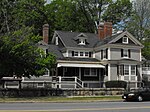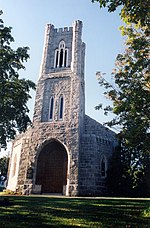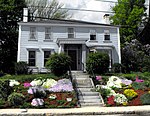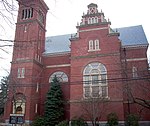First Baptist Church (Methuen, Massachusetts)
1815 establishments in Massachusetts19th-century Baptist churches in the United StatesBaptist churches in MassachusettsBuildings and structures in Methuen, MassachusettsCarpenter Gothic church buildings in Massachusetts ... and 4 more
Churches completed in 1869Churches in Essex County, MassachusettsChurches on the National Register of Historic Places in MassachusettsNational Register of Historic Places in Methuen, Massachusetts

First Baptist Church is an historic Baptist church building at 30 Park Street in Methuen, Massachusetts. Built in 1869 for a congregation established in 1815, it is one of the town's finest examples of Carpenter Gothic architecture. It was listed on the National Register of Historic Places in 1984.
Excerpt from the Wikipedia article First Baptist Church (Methuen, Massachusetts) (License: CC BY-SA 3.0, Authors, Images).First Baptist Church (Methuen, Massachusetts)
Lawrence Street, Methuen
Geographical coordinates (GPS) Address Nearby Places Show on map
Geographical coordinates (GPS)
| Latitude | Longitude |
|---|---|
| N 42.728055555556 ° | E -71.185 ° |
Address
Lawrence Street 257
01841 Methuen
Massachusetts, United States
Open on Google Maps











